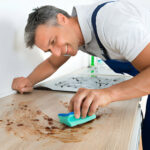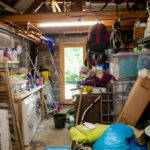
Because of its strength and adaptability, concrete flooring has grown in popularity for both residential and commercial spaces. But, to maintain its durability and industrial-chic appeal, concrete needs to be properly cared for. In this extensive guide, we share the secrets of keeping your concrete floors immaculate, from routine cleaning procedures to dealing with tough stains and putting preventive measures in place. Let us explore the world of maintaining and enhancing the beauty of your concrete flooring.
Click here to also have a glance at our post on How to Clean and Maintain Your Ceramic Tile Flooring.
What to Know About Your Concrete Flooring
Types of Concrete Finishes
Concrete floors come in various finishes, including polished, stained, and sealed. Understanding the specific finish of your concrete is crucial for implementing the right cleaning and maintenance strategies. Each finish has unique requirements to maintain its appearance and integrity.
Common Issues with Concrete Flooring
Concrete floors may face challenges like stains, scratches, and surface dullness. Identifying common issues allows you to tailor your cleaning and maintenance routine to address specific concerns. Whether it’s a spilled glass of red wine or the wear and tear of daily foot traffic, knowing the potential pitfalls empowers you to protect your flooring.
Sealed vs. Unsealed Concrete
Determine whether your concrete flooring is sealed or unsealed. Sealed concrete provides an added layer of protection against stains and moisture, requiring different cleaning approaches. Unsealed concrete, while more porous, allows for different maintenance techniques.
Identifying the Cause of Stains
Stains on concrete flooring can result from various sources, including food, oil, or rust. Identifying the cause of a stain helps in choosing the appropriate cleaning method. Whether it’s a spill from a dinner party or an accidental oil leak in the garage, targeted stain removal ensures a spotless surface.
Understanding the Importance of Maintenance
Routine maintenance is key to preserving the longevity and aesthetic appeal of your concrete flooring. Regular cleaning and preventive measures not only keep the floors looking pristine but also contribute to their overall durability.
See also our post on A Comprehensive Guide on How to Clean and Maintain Your Cork Flooring which you will not want to miss.
Routine Cleaning Practices
Daily Dusting and Sweeping
Dust and debris can accumulate on concrete floors, dulling their shine over time. Daily dusting with a microfiber mop or soft broom prevents this buildup. Sweeping removes abrasive particles that can scratch the surface.
Mopping with a pH-Neutral Cleaner
Use a pH-neutral cleaner for routine mopping. Mix the cleaner with warm water and mop the floor, focusing on high-traffic areas. Avoid acidic or abrasive cleaners, as they can damage the finish of your concrete.
Handling Spills Immediately
Spills, whether from liquids or substances like oil, should be addressed promptly. Wipe up spills using a soft cloth or paper towel to prevent staining. For stubborn stains, a mild cleaning solution may be necessary.
Periodic Deep Cleaning
Perform periodic deep cleaning to remove embedded dirt. Use a mild floor cleaner suitable for your specific concrete finish. Scrub the floor with a soft-bristle brush or a floor scrubber, paying attention to corners and edges.
Avoiding Harsh Cleaning Tools
Steer clear of harsh cleaning tools like wire brushes or abrasive pads, as they can scratch and damage the surface. Opt for soft brushes or pads designed for cleaning concrete floors to ensure gentle yet effective maintenance.
See also our post on The Complete Guide to Cleaning and Maintaining Your Engineered Hardwood Floors
Addressing Stubborn Stains
Oil and Grease Stains
Oil and grease stains are common in areas like garages. Absorb excess oil with cat litter or baking soda, then scrub the area with a mixture of water and dish soap. Rinse thoroughly and repeat as needed.
Removing Rust Stains
Rust stains, often a result of metal furniture or tools, can be challenging. Use a mixture of lemon juice and salt or a commercial rust remover. Apply the solution, scrub gently, and rinse thoroughly to avoid any residue.
Handling Food and Beverage Stains
Food and beverage spills, such as coffee or red wine, should be addressed promptly. Blot the spill with a clean cloth, then clean the area with a mixture of mild soap and water. Rinse thoroughly to prevent soap residue.
Addressing Paint Stains
Paint stains can occur during home improvement projects. Scrape off excess paint using a plastic scraper, then apply a mixture of warm water and mild detergent. Scrub gently and rinse thoroughly.
Dealing with Gum or Wax
Freeze gum or wax using ice, then gently scrape it off with a plastic scraper. Any residue can be removed with a mixture of warm water and mild soap. Avoid using sharp tools that may damage the concrete.
Preventive Measures
Using Doormats
Place doormats at entry points to trap dirt and prevent it from being tracked onto your concrete floors. This simple measure significantly reduces the amount of debris that reaches the interior.
Furniture Pads and Area Rugs
Attach furniture pads to the legs of chairs and tables to prevent scratches when moving furniture. Use area rugs in high-traffic zones to provide an additional layer of protection.
Regularly Inspecting Sealant
If your concrete flooring is sealed, regularly inspect the sealant for signs of wear. Reapply sealant as needed to maintain its protective properties. This preventive step guards against stains and moisture penetration.
Avoiding Harsh Chemicals
Refrain from using harsh chemicals or acidic cleaners on your concrete floors. These can erode the finish and compromise the integrity of the concrete. Stick to mild, pH-neutral cleaners for routine maintenance.
Maintaining Proper Humidity Levels
Maintain proper humidity levels to prevent moisture-related issues like mold or mildew. Use a dehumidifier if needed, especially in basements or areas with limited ventilation.
Seasonal and Long-Term Care
Preparing for Winter
In colder climates, prepare your concrete floors for winter by removing salt and ice melt residues. Sweep or mop the floors to prevent abrasive particles from causing damage. Consider using rugs in entryways to capture winter debris.
Avoiding Water Puddles
Standing water can seep into the porous surface of unsealed concrete. Avoid water puddles and promptly dry any wet areas to prevent potential damage. Proper drainage around your home also contributes to preventing water accumulation.
Regularly Inspecting for Cracks
Periodically inspect your concrete floors for cracks or damage. Cracks may develop over time, and addressing them promptly prevents further deterioration. Fill small cracks with a concrete patching compound.
Professional Maintenance and Refinishing
Consider professional maintenance and refinishing for your concrete floors, especially if they show signs of significant wear or damage. Professionals can assess the condition of your floors and recommend appropriate treatments.
Reevaluating Floor Finishes
Over time, the finish on your concrete floors may wear down. Reevaluate the condition of the finish periodically and consider refinishing if necessary. This step enhances both the appearance and protection of your concrete flooring.
Here is our post on How to Clean and Maintain Your Porcelain Tile Flooring
Conclusion
Concrete flooring can be a beautiful addition to your house or place of business because of its timeless appeal and durability. You can make sure that your concrete floors stay shiny for years to come by learning about the subtleties of your particular concrete finish, following routine cleaning procedures, acting quickly to remove stains, and taking preventive measures. Whether it is daily dusting, seasonal preparations, or dealing with tough stains, this comprehensive guide will arm you with the knowledge to bring out the shine and longevity of your concrete flooring.







